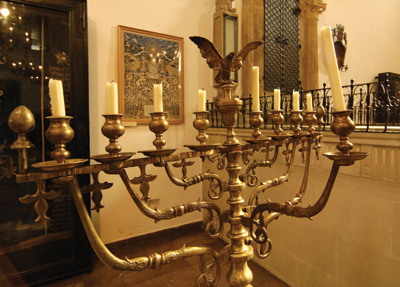|
HANUKKA
Mordechai’s Famous Song
The most famous
Hannuka song probably is the poem sung immediately after the lighting of
the candles: Maoz Tzur. It was written in one of the Germanic countries
in the thirteenth century by someone who was named Mordechai. His name
is known to us only from the acrostic that appears in the first five
stanzas of the song.
Most scholars accept
the theory that this Mordechai is Rabbi Mordechai Ben Hillel of
Nuremberg and that his writing was influenced by the persecution of Jews
throughout Europe during the Crusades. Mordechai ben Hillel also is the
author of a halachic book and other religious poems and prayers, all of
which contain the acrostic Mordechai.

The hanukiyya from the Great Synagogue in
Cracow. (Daniel Schwartz)
Mordechai ben Hillel
was murdered in a pogrom in Nuremberg together with 600 other Jews. His
name is the most prominent of all the names that appear in the laments
for this event. The vengeance for the victims of the pogrom, a source
from the time says, will be “like the vengeance of the blood of your
servants” – the exact same words that appear in the last stanza of Maoz
Tzur.
The first stanza
deals with the consecration of the Temple, where God will save his
people from the many dangers of this world. The next four stanzas give
examples: the first mentions the delivery from the pharoah in Egypt; the
second, delivery from the Babylonian exile; and the third, delivery from
Haman – the Purim story. Finally, the fourth stanza provides the poem’s
connection to Hannuka – the delivery from the Greeks by the Hasmoneans.
(Most families only sing the first and fifth stanza of Maoz Tzur.)
The last stanza, the
sixth one, is so grim and vengeful that some researchers have concluded
it is a later addition. In any case, it was taken out of the prayer
books in Germany because of the words “avenge the blood of thy
servants.”
Expose your arms of
holiness
And bring nearer the
end of redemption
Avenge the blood of
thy servants
From the wicked
nation
Because redemption
has tarried
And the bad days
seem endless
Throw back the red
one
In the shadow of the
cross
And bring forth for
us seven shepherds.
The red one
mentioned in the sixth stanza is probably the German Kaiser Frederick
Barbarossa, who had a red beard and was one of the leaders of the third
crusade.
The tune of Maoz
Tzur is a combination of three popular German songs that were sung in
Germany and Eastern Europe in the fifteenth and sixteenth centuries.
Initially, Maoz Tzur was sung only in Ashkenazi communities. However, in
the last few generations, it has spread to Sephardi communities also.
ERETZ Staff
This
article
appeared in ERETZ Magazine 106. To subscribe to ERETZ Magazine,
click
here.
|

